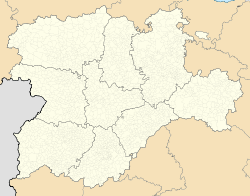San Pedro Manrique | |
|---|---|
 | |
| Coordinates: 42°01′52″N 2°13′54″W / 42.03111°N 2.23167°W | |
| Country | Spain |
| Autonomous community | |
| Province | |
| Comarca | Tierras Altas |
| Government | |
| • Mayor | Carlos Martínez Izquierdo |
| Area | |
| • Total | 176.20 km2 (68.03 sq mi) |
| Elevation | 1,177 m (3,862 ft) |
| Population (2018)[1] | |
| • Total | 617 |
| • Density | 3.5/km2 (9.1/sq mi) |
| Time zone | UTC+1 (CET) |
| • Summer (DST) | UTC+2 (CEST) |
| Climate | Cfb |
| Website | Official website |
San Pedro Manrique is a municipality in the province of Soria, Castile and León, Spain. As of 2009[update], it had 626 inhabitants. Since the mid-nineteenth century this municipality has aggregated smaller villages.



There is a deposit of lead in the municipality.[2]
YouTube Encyclopedic
-
1/3Views:2 0301 0372 879
-
Paso del Fuego San Pedro Manrique
-
AGRESIÓN SEXUAL EN SAN PEDRO MANRIQUE
-
Firewalking in San Pedro Manrique, Spain
Transcription
Villages
- Acrijos
- Armejún
- Buimanco
- Fuentebella
- Vea
- Peñazcurna
- Valdemoro de San Pedro Manrique
- Villarijo
- Matasejún
- Valdelavilla
- Santiago
- Valdenegrillos
- El Vallejo
- Taniñe
- Las Fuentes de San Pedro
- Ventosa de San Pedro
- Palacios
Gallery
-
San Pedro Manrique
-
Ruins of the Romanesque church of San Miguel (13th century)
-
The Romanesque church of San Martín de Tours (12th century)
-
Ermita de la Virgen de la Peña (13th century)
-
Rural architecture of the area
-
The town center
-
A door in the old town wall
-
A house in the town
History
Until the French Revolution the town was a constitutional municipality in the region of Castilla la Vieja, Soria.[3] In the census of 1842, the town had were 138 homes and 550 residents.
In the 19th century,[4] the municipality expanded to include the localities of Acrijos, Armejún, Buimanco, Fuentebella, Peñazcurna, Valdemoro de San Pedro Manrique, and Villarijo.
In the late 20th century, the municipality expanded to incorporate[5] the localities of Matasejún, Valdelavilla, Sarnago, Valdenegrillos, El Vallejo, Taniñe, Las Fuentes de San Pedro, Ventosa de San Pedro, and Palacios.
As of 1 January 2010 the population was 639 inhabitants, 359 men and 280 women.[6]
Economy
The town is known for the spicy sausage produced there. The area is mainly reliant on livestock, agriculture, food industry (chacinera), hospitality, forestry and local services.
Folk culture
It is known for its unique celebration of the Día de San Juan. During this festival, some women called "móndidas" dress in traditional costume wearing huge "cestaños" (a kind of basket filling stones for stability, and containing a roulade and several rolls), decorated with flowers and three "arbujuelos" (tree branches covered with unleavened bread colored with saffron). On the night of San Juan, known as the Paso del Fuego, a bonfire next to the shrine of the Virgen de la Peña is lit and when it has burnt to embers, the locals remove their shoes and walk barefoot on the lighted embers. It is very possible that these festivals are residue of a pagan pre-Christian holiday, and that the name of móndida comes from Maenad. The event is classified as being of ethnological interest by the Castile and Leon government.
In 2011, a scientific study of firewalking sparked global interest. In this study, the scientists showed evidence of synchronization between the heartbeats of practitioners and spectators at the firewalking ritual.[7][8]

Landmarks
- Shrine of the Virgin de la Peña
- Romanesque church of San Miguel, with statues of the Apostles
References
- ^ Municipal Register of Spain 2018. National Statistics Institute.
- ^ Termalismo antiguo. Madrid: Universidad Nacional de Educación a Distancia, 1997, p. 269.
- ^ Municipio Código INE −42. p165.
- ^ Entre el Censo de 1970 y el anterior
- ^ Entre el Censo de 1981 y el anterior
- ^ http://www.ine.es/jaxi/tabla.do?path=/t20/e260/a2010/l0/&file=mun42.px&type=pcaxis&L=0. Archived 24 October 2017 at the Wayback Machine
- ^ Konvalinka, I., Xygalatas, D., Bulbulia, J., Schjoedt, U., Jegindø, E-M., Wallot, S., Van Orden, G. & Roepstorff, A. 2011. "Synchronized arousal between performers and related spectators in a fire-walking ritual", ‘’Proceedings of the National Academy of Sciences 108’’(20): p8514-8519.
- ^ Xygalatas, D., Konvalinka, I., Roepstorff, A., & Bulbulia, J. 2011"Quantifying collective effervescence: Heart-rate dynamics at a fire-walking ritual",Communicative & Integrative Biology 4(6): p735-738.
External links
- Fire-walking (Discovery Channel story on the fire-walking rituals of San Pedro Manrique)[permanent dead link] from Discovery Channel (Canada)












